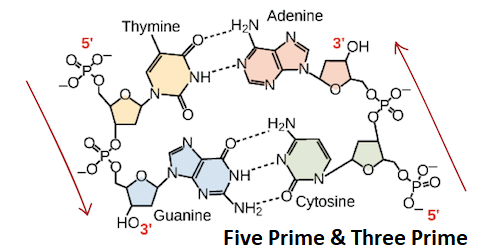
How can you identify the
Answer
392.7k+ views
Hint: A base pair refers to two bases that constitute a rung of the DNA ladder. A DNA nucleotide is constituted by a molecule of the base, a molecule of sugar, and a molecule of phosphoric acid. The bases are the letters, which spell out the genetic code. The code letters are C, G, T, and A, representing cytosine, guanine, thymine, and adenine respectively. The guanine base always pairs with a cytosine base, while adenine always forms a pair with a thymine base.
Complete answer:

Fig: Representation of the ends of DNA
Just like letters and words in English are read from left to right, DNA is ‘read’ in a particular direction. Besides, each end of DNA is represented by a number. One end of the DNA is named as
Carbons of the sugar are numbered in the clockwise direction, beginning from the oxygen atom. This asymmetry provides the DNA strand a ‘direction’ and the bases in the DNA are read in the
Nucleic acid possesses an end-to-end chemical orientation like a polypeptide. The
Note:
The orientation of the two strands is opposite, that’s they are antiparallel. A single strand of DNA has an unbound
Complete answer:

Fig: Representation of the ends of DNA
Just like letters and words in English are read from left to right, DNA is ‘read’ in a particular direction. Besides, each end of DNA is represented by a number. One end of the DNA is named as
Carbons of the sugar are numbered in the clockwise direction, beginning from the oxygen atom. This asymmetry provides the DNA strand a ‘direction’ and the bases in the DNA are read in the
Nucleic acid possesses an end-to-end chemical orientation like a polypeptide. The
Note:
The orientation of the two strands is opposite, that’s they are antiparallel. A single strand of DNA has an unbound
Recently Updated Pages
Master Class 12 Business Studies: Engaging Questions & Answers for Success

Master Class 12 English: Engaging Questions & Answers for Success

Master Class 12 Social Science: Engaging Questions & Answers for Success

Master Class 12 Chemistry: Engaging Questions & Answers for Success

Class 12 Question and Answer - Your Ultimate Solutions Guide

Master Class 11 Economics: Engaging Questions & Answers for Success

Trending doubts
Draw a labelled sketch of the human eye class 12 physics CBSE

a Tabulate the differences in the characteristics of class 12 chemistry CBSE

Which one of the following is a true fish A Jellyfish class 12 biology CBSE

Why is the cell called the structural and functional class 12 biology CBSE

Differentiate between homogeneous and heterogeneous class 12 chemistry CBSE

Write the difference between solid liquid and gas class 12 chemistry CBSE




